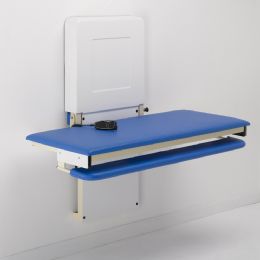















What are Pediatric Changing Tables?
Changing tables provide a secured location in which to attend to changing diapers and clothing on babies and children. While we do carry changing tables for adults and larger children, the tables in this category are intended for usage with small children, toddlers and newborns. Because diapers on babies need changing on average at least five times a day, a changing table offers a more permanent and secured space to do this than a floor, bed or top of a dresser.
Available in a variety of designs and styles, pediatric changing tables are used for both professional and private applications. With their durable construction, they will stand up to the repeated and heavy usage inside a medical or care facility, and can certainly be easy to maintain for years of use at home, as well.
Pediatric changing tables are often constructed with wood, laminates, coated metals or tough plastics, and often come in various colors and styles to match existing décor. Some styles are combination dresser-changing tables, while others can attach to a wall and fold up when not in use. Several formats feature rolling and locking capabilities, so that they can be transported easily from room to room, and then they can be locked firmly in place when they are actively being used.
Changing Table Features and Safety
Pediatric changing tables offer a wide range of configurations and safety features so that parents and caregivers can find exactly the right fit for their own families’ requirements.
Ergonomics and Height Adjustability—many changing tables are ergonomically designed to make them more comfortable for the attending parents or caregivers. These tables and others also often include height adjustability to ensure the correct working height for the attendant’s posture, with some offering foot controls for hands-free adjustability. Changing the baby or child at the right height helps protect against back and knee problems.
Folding/Collapsible—some changing table types may attach to the wall and fold up when not in use, or may fold down or be collapsible to save space. This type is perfect for smaller rooms and spaces.
Guardrails and Safety Straps—most changing tables offer some kind of securing system, such as safety railings, guard rails and/or safety straps or belts. While the American Academy of Pediatrics recommends a guardrail that is at least two inches high on all sides, the higher the protective rail around the table, the better. No matter what securing system you use, it is always important that you watch your baby at all times while he or she is on the changing table to reduce the risk of falls and accidents. Never leave a baby or young child unattended on a changing table.
Contoured Changing Surface—the actual changing surface of the table should be lower in the middle as this helps to keep infants from moving or rolling from side to side. Some models get more involved with the mat design, and may be more appropriate for special needs babies and children.
Storage—many changing table formats highlight shelves, drawers or compartments for storing diapers and other changing supplies. This helps to keep the items needed close and conveniently at hand, yet out of the baby’s reach.
Versatility—after use is no longer required as a changing table, most of these tables can be utilized to store toys, clothing, blankets and other items for years to come. The top can be turned into a shelf for books, to hold a lamp, or for displaying favorite decorative items.
Rehabmart also offers Adult Changing Tables.
Hulet Smith, OT
Rehabmart Co-Founder & CEO
ck